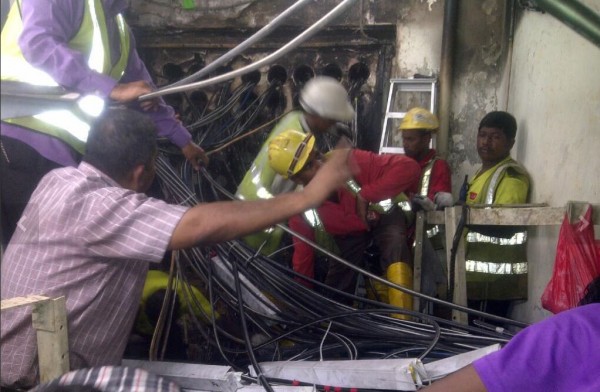
(source: SingTel)
The answer to that question should be pretty straightforward for users.
Whether you are surfing at home or sending e-mails from the office, the network is expected to be up all the time. When it’s down, it has to be fixed fast, so things resume with minimum fuss.
That’s the crux of the issue when you talk about how resilient a network is.
Yet, it seems completely lost on Singapore’s industry players as they angrily point fingers at one another this week, after the widespread disruption caused by a fire at a SingTel exchange.
SingTel’s rivals were initially upset that it had not fixed its damaged fibre optic cables at the exchange fast enough. That it shared so much in manpower and infrastructure with the national broadband network owner OpenNet raises concerns about fair competition, went the complaint.
The government regulator, under pressure from the public, then issued a rare retort – telcos can build their own networks if they don’t want to rely so much on SingTel.
Lost in all this is a user’s basic expectation that the nationwide broadband network, built at huge expense, should be up and running without fuss. When it does run into issues, as all computers and networks do, the remedy should be swift.
What’s so hard to understand about that? Unfortunately, instead of supplying ideas on how to fix things, industry members seem keener to argue among themselves.
If you are a home or business user trying to understand what’s going on with these quarrelsome telcos, here are the questions you should ask.
Just how resilient are Singapore’s telecom networks?
There doesn’t seem to be a standard measure yet, but the Infocomm Development Authority (IDA) this week came out to say yes, Singapore’s networks are resilient.
To many users, that just doesn’t cut it. How can the IDA be so sure before its investigations on the disruptions are complete? The length of the outage (up to a week for some users) and widespread impact (including ATMs, electronic payment terminals and even a betting service) don’t suggest that everything is fine.
At the heart of the issue is how the fire started. Is it a one-off incident that does not appear likely to be repeated? Or does it betray a systemic issue?
Without answering these questions, the IDA cannot say confidently that Singapore’s networks are resilient. It needs quantitative measurements to back up its claim.
Just like how it measures network uptime or 3G coverage, it needs standards in place for how fast a telco recovers from such an issue.
How many hours, for example, should a telco take to recover from that much damage at an exchange? Only if such a test is passed should the IDA say yes, the nation’s networks are resilient.
Why can’t we have a duplicate network as backup?
The simple answer is cost. Unlike buying a cheap hard disk to “mirror” or back up data, building a completely separate telecom network costs a lot more.
While fibre optic cables and the manpower needed to lay them are getting cheaper, the most daunting and costly task for telcos is digging up roads and getting access to reach that last 100 metres from the road to inside your building.
That makes it extremely expensive to build a duplicate network. No, scratch that, actually, there’s a 20-year-old network connection in each home already and that’s StarHub’s cable TV network. Remember the old Singapore Cable Vision digging up roads not so long ago?
Yes, but would you buy two broadband services to run in parallel – for “redundancy” in geek-speak – just to prepare for a day when one network goes down? Nope. Now, why don’t telcos roll out a parallel network? Same answer – it’s expensive.
What are these complaints about SingTel owning OpenNet?
A SingTel-owned business trust is in the process of buying OpenNet, subject to IDA’s approval. There are many issues involved, such as how competitive the market can remain if SingTel takes control once again of the nationwide network (read our commentary).
But this has got little to do with how resilient the country’s networks are. Since SingTel is the sole operator of such exchanges as the Bukit Panjang one that caught fire, the real issue is making sure it runs them well and makes sure it recovers from incidents speedily.
Yes, SingTel’s rivals connect through these exchanges too. They can demand that SingTel do its job properly, by re-connecting every telco with the same priority in a recovery job. But beyond that, there’s really no point bringing up this proposed sale of OpenNet, which is a separate issue.
Remember, these telcos can set up their own parallel, duplicate, and maybe better-run networks. Why don’t they? Cost. StarHub has said as much. It leases from SingTel and only builds its own networks “where it made economic sense“.
To rivals, SingTel is both the big, bad “legacy” telco that hates competition and the one owning all the ducts dug into the ground years ago that they can lease for a lower cost than building their own.
Yes, the relationship is complicated. When these telcos squabble, however, they shouldn’t complicate things for users by bringing in unrelated issues.
What can the regulator do?
Since the IDA doesn’t own the networks, it can only beat the telcos with a stick, repeatedly.
To its credit, it is stepping up with audits of key infocomm infrastructure, just like it has done with mobile networks after several high-profile outages in recent years.
It should also study what the standards are in other countries, notably in Japan, then adapt the best practices here.
What can users do?
If your business absolutely depends on an Internet connection, then perhaps wireless connections over 3G or 4G networks might be an alternative.
That is not a substitute – usually backups are not – because the speeds are slower and 4G data costs more. But that’s still more practical than signing up with another provider, which may also be hit if a similar fire broke out at a nearby exchange, anyway.
Ultimately, there’s little that most users can do in an office or home when such a critical node in the national network is down.
As the IDA rightly points out, just like the water pipe that brings tap water to your home, some parts of the telecom network are hard to replicate. Of course, that water pipe almost never fails, and that’s how the telecom network should be too.







bottom line. getting worst!!! Quality of services dropped, voice calls dropped both static and on the move dialling time taking longer to connect, broadband throughput in MBS are not warranted and can change drastically, 3/4 G network band coverage, fibre access is not all ready, and customer services getting worst – Ask too many unrelated questions when called.
the crux of it is how does one defines resilient.
someone viewing it as fibre broadband by itself will unlikely agree that it is resilient after what happened, but as you rightly pointed out there is also 3G/4G, cable broadband, and then there is adsl too. when considered collectively, one can argue that there is some resilient. however which person and how many organisations will subscribe and use all forms of services in practice? plus what is the cost for consumer to do so? thus if the cost of subscribing to all forms of services in practice is expansive and impractical to do so, do the resilient argument still applies?
for the home consumer, having broadband down can be annoying, but for the moment because not every thing is dependent on it yet, beyond that it shouldn’t have any impact. therefore the current setup should do.
for the home consumer who uses it for work, and commercial organisations like banks, and companies dealing with online commerce, it will probably depends on how mission critical it is. users that really need the internet for work has the option of subscribing to every forms of service as impractical as it sounds and hope not every thing goes down at once. cost benefit analysis will apply here. if losses can be great, it may well justify such expenditure.
then there are the medical organisations and emergency services. depending on what they use broadband for, it maybe essential for them. a no system failure situation could apply.
finally even if broadband and telephone system are down, there is always the old fashion mail system, somehow resilient can always be argued, although i think it will be stretching it a bit too far.
Why is IDA defending Singtel in the first place?
IDA has not been deliver their job as a regulator . They failed to protect the consumer interests.